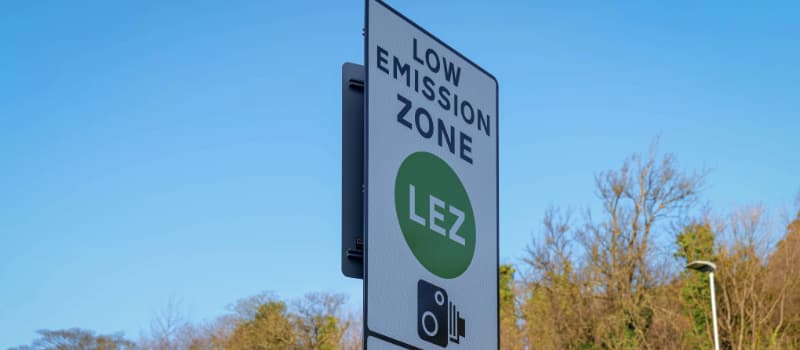
The mistake that could cost you thousands when you buy a used car
8th Nov, 2024
It probably comes as no surprise to learn that the UK’s second hand vehicle market continues to grow, as the ongoing cost of living crisis causes countless people across the UK to avoid the more expensive new car market, and go for more budget-friendly options instead. If you’re considering a used car yourself though, there are a couple of key factors to bear in mind to ensure that you’re not buying what they call a lemon.
Now, some of those checks are fairly common knowledge – you may already know about an HPI, for example – but there’s one particular factor that’s more important than ever… and it’s one that a lot of drivers forget.
Check that your car is emissions-compliant
With the climate crisis now more urgent than ever, Low Emissions Zones now play an ever-larger role in the lives of everyday motorists. Essentially, if you live near a Low Emissions Zone or an Ultra Low Emissions Zone, or you know that you’re likely to be driving through one, then you’ll need to check that the car you’re planning on buying is compliant with the restrictions of your local zone.
Emissions zones are becoming increasingly common in major city centres (which are typically hotbeds of air pollution due to their higher concentrations of traffic). Some of the most high profile ones include massive cities like London and Birmingham, but they’re also present in Sheffield, Bath, and Bristol.
We’ve explained Low Emissions Zones in more detail before here on the blog, but to quickly recap it in a nutshell, the idea is to encourage the purchase of newer, cleaner vehicles by charging non-compliant ones an entry fee. The amount varies, but it’s potentially up to £12.50 per day.
How do the charges work?
The wording on the legislation around these daily charges is very specific – essentially, it allows authorities to charge vehicles not just for entering the zone, but just being present within its boundaries. It might not sound like a major difference, but it’s very significant.
That means in any instance in which your car travels into the zone and leaves on the same day, then obviously you’ll only have to pay the daily charge for that day.
If you travel into the zone and leave on the next day, then you’ll have to pay the daily charge for both days.
However, the charges also apply if your car is parked up within the zone too, even if you didn’t move it at all during the day. So if you travelled in on Friday and parked up, then didn’t move the car at all on Saturday, and then drove out on Monday, you’d have to pay the daily charge for all three days – because your car would have been present within the zone for all that time, even if it didn’t move at all on the Saturday.
So you can already see how these charges can start to rack up!
How can I avoid being caught out?
The easiest way is simply by making sure you do enough research in the interim. Newer cars are manufactured to generally stricter environmental standards, but older cars often don’t share these emissions standards, especially if they’re anything more than a couple of years old.
So, you’ll need to check the requirements for your local Low Emissions Zones (assuming you have any), as well as any that you think you’ll be travelling to often. For example, if you know you’ll be going back and forth to London a lot.
There are four classes of Clean Air Zone – A through to D. (You’d think that A is the strictest and D is the most lax, but it’s actually the other way around!)
Class A Clean Air Zones
Restrictions apply only to buses, coaches, taxis, and private hire vehicles. They do not apply to privately owned cars (like yours).
Class B Clean Air Zones
The restrictions apply to buses, coaches, taxis, private hire vehicles, as well as heavy goods vehicles. Example cities:
- Portsmouth
Class C Clean Air Zones
Restrictions apply to buses, coaches, taxis, private hire vehicles, heavy goods vehicles. They also apply to vans and minibuses. Example cities include:
- Bath
- Bradford
- Sheffield
- Tyneside (Newcastle and Gateshead)
Class D Clean Air Zones
Restrictions apply to almost every vehicle that crosses into (or exists within) the zone’s boundaries, with only a select few exceptions. This includes buses, coaches, taxis, private hire vehicles, heavy goods vehicles, vans, minibuses, and privately owned cars. The local authority has the option to include motorcycles
Example cities include:
- Bristol
- Birmingham
The whole point is that it gets polluting cars off the road, and the idea is that eventually everyone gets cleaner and newer ones. So if you ever get to the point when you decide: I need to scrap my car, then you’re in exactly the right place. With decades of experience to our name here at Scrap Car Network, we’re committed to helping you get the very best price for your scrap car.
All you need to do is enter your car reg and postcode into the fields on our site, and we’ll get you an instant online quote before you can say cash for cars. It only takes a few seconds. Curious to find out how much your car is worth?